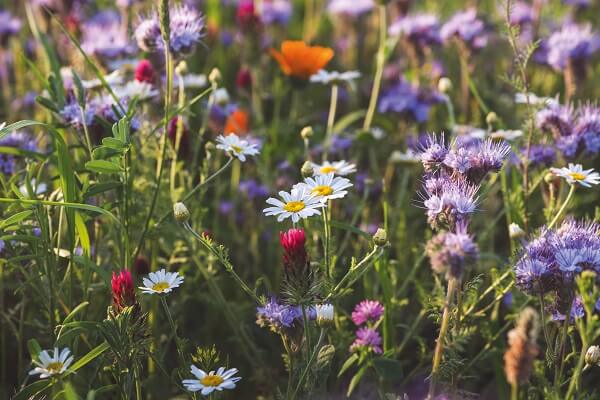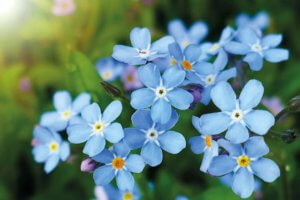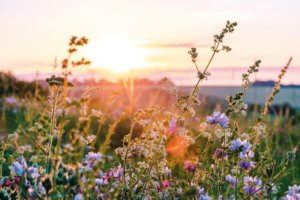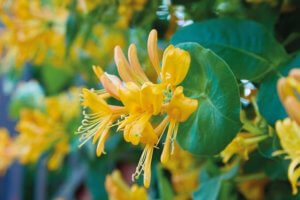Let’s Get Wild

Turn your garden into a veritable paradise for the birds and the bees by creating a wildflower meadow. Simple, environmentally beneficial and stunningly beautiful.
Manicured lawns and glamorous show gardens may be all the rage these days, but nothing quite compares to the raw, untamed beauty of wildflowers. Providing an unrestrained explosion of colour and character to your home, wildflowers are the ideal choice for someone who craves the delights of the garden, but doesn’t have time to spend hours cultivating their plot.
Not only is it easy to create your own little wildflower meadow, it’s also fast, meaning that any patch of land you have bare can be germinated in a matter of months. That means you could be gazing out over a carpet of poppies, cornflowers, daisies, cowslips and bluebells as summer draws to a close.
Perennial flowers will flourish in uncultivated soil, whereas cornfield flowers will do better in richer earth. You can buy ready-mixed seeds which will be tailored to certain variables such as soil containing heavy clay, boggy land by the pond’s edge, or even seeds that are specifically combined to provide the maximum nourishment to bees – such pollinators include Sunflower, Borage, Evening Primrose and Corn Marigold.
Make sure you thoroughly weed the soil before scattering your seeds – you need 1g per square metre of pure wildflower seeds and 5g per square metre of grass and wildflower meadow seeds – and ensure the earth remains consistently moist thereafter.
Once your meadow starts to bloom, spend the odd afternoon clearing away dead plants and weeds to allow new seeds to sow. You may also need to add more seeds the following year or two, but rest assured that once your wildflower meadow is established it will provide you (and the humble bumble bees) joy for years to come.
Must-have wildflowers for your garden
Forget-me-not
 Suitably unforgettable, this lovely lilac biennial bloom not only adds a spray of colour to your lawn, but it also attracts various pollinators, and its leaves are eaten by the caterpillars of several moth species bringing an abundance of insect life to your garden.
Suitably unforgettable, this lovely lilac biennial bloom not only adds a spray of colour to your lawn, but it also attracts various pollinators, and its leaves are eaten by the caterpillars of several moth species bringing an abundance of insect life to your garden.
Hemp Agrimony
This noble native perennial looks rather striking when grown amid other more colourful wildflower varieties. Preferring the shade, it grows tall and untamed and provides a delectable nectar for butterflies.
Ox-eye Daisies
Nothing says ‘British summer has arrived’ quite like the daisy. Tall and gracious, these white and yellow beauties are easy to grow – they thrive in the sun – though they can also overwhelm a plot if not kept in check.
Cornflowers
Native to mountain meadows and woodland in Europe, the blue cornflower is a favourite. The variety ‘Purple Heart’ has brilliant white flowers with deep purple stamens that bees, unsurprisingly, find irresistible.
Common Knapweed
 Despite its name, there is nothing common about this charming thistle. Though some may view it as a pest, it nonetheless brings its own rugged loveliness to your wildflower crop and also will provide food for birds if seed heads are left over winter.
Despite its name, there is nothing common about this charming thistle. Though some may view it as a pest, it nonetheless brings its own rugged loveliness to your wildflower crop and also will provide food for birds if seed heads are left over winter.
Honeysuckle
 What flowerbed is complete without a smattering of Honeysuckle? With its vibrant white, pink and yellow petals and unusually long tendrils, one might be forgiven for thinking this a flower from another planet, but this fragrant bloom is as British and as iconic as they come.
What flowerbed is complete without a smattering of Honeysuckle? With its vibrant white, pink and yellow petals and unusually long tendrils, one might be forgiven for thinking this a flower from another planet, but this fragrant bloom is as British and as iconic as they come.
Foxgloves
Another ubiquitous garden dweller is the Foxglove. Bright, abundant and beautiful with its tubular purple flowers, these are ideal for the back of your miniature flower meadow as they grow tall and regal attracting many a
bumblebee.
